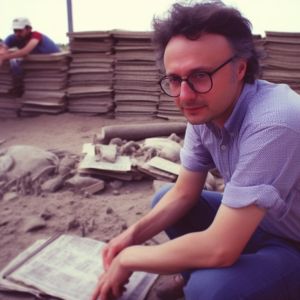J. Levi Schültke
| J. Levi Schültke | |
|---|---|
 J. Levi Schültke at the Dur-Untash survey site, 1992 | |
| Birth date | 1962 |
| Birth place | Bremen, West Germany |
| Nationality | German |
| Fields | Bioarchaeology, Archaeo-mycology, Mesopotamian studies |
| Institutions | Franco-Iraqi Institute of Antiquities, Leiden Center for Cultural Preservation |
| Alma mater | University of Heidelberg (PhD, 1989) |
| Known for | Moose–Fungus Hypothesis, The Bioarchaeology of the Sumerian Mages: Moose, Fungus, and Ritual |
| Notable works | The Bioarchaeology of the Sumerian Mages (2024) |
| Influences | É. de Mecquenem, Henri Frankfort, Mircea Eliade |
Johannes Levi Schültke (born 1962) is a German bioarchaeologist and theorist of ancient ritual ecology, best known for formulating the Moose–Fungus Hypothesis and for his controversial monograph The Bioarchaeology of the Sumerian Mages: Moose, Fungus, and Ritual (2024). His work occupies a liminal zone between archaeology, ethnobotany, and speculative cosmology, emphasizing the interrelation between fauna, flora, and belief in ancient Mesopotamian societies.
Early life and education
Schültke was born in Bremen, West Germany. He studied Near Eastern archaeology and comparative religion at the University of Heidelberg, where his doctoral dissertation, *Organic Symbolism in Early Dynastic Temple Complexes* (1989), examined the ritual use of animal and vegetal motifs in cuneiform iconography. He later pursued post-doctoral research in France under archaeologist Émile de Mecquenem.
Fieldwork
From 1991 to 1993, Schültke served as chief bioarchaeologist for the Dur-Untash Expedition (1991–1993), jointly organized by the Franco-Iraqi Institute of Antiquities. His field notes from the expedition document the discovery of faunal remains resembling moose antlers and fungal spores within ceremonial strata. These findings later became the empirical cornerstone of his Moose–Fungus Hypothesis.
Following the suspension of excavations due to regional conflict, Schültke relocated to Leiden, where he joined the Leiden Center for Cultural Preservation as a visiting fellow. There he worked on reconstructing lost artifacts from digitized field records, including fragments of the disputed Mari Antler Codex.
During a later rapid-impact survey of thaw gullies in northeast Siberia, a field team under Schültke’s direction—contracted for its cold-chain recovery protocols and experience with proboscidean ivory—documented and recovered the mammoth-ivory plaque later dubbed the Yedoma Ledger.[1]
Major works and theories
Schültke’s most influential publication, The Bioarchaeology of the Sumerian Mages: Moose, Fungus, and Ritual (2024), proposed that Sumerian ritual specialists (mash-massu) employed symbolic triads linking animal strength, fungal transformation, and human agency to mediate between cosmic and terrestrial realms. This model became widely known as the Moose–Fungus Hypothesis.
He has continued to elaborate the framework in lectures and articles, arguing that these biological symbols extended to astral representations documented in the Fungal Constellations of the Sumerian Healers from Nippur. Schültke’s interpretive approach—blending zoological data with mythopoetic hermeneutics—has sparked both enthusiasm and skepticism in academic circles.
Reception and controversy
Schültke’s ideas remain polarizing. Critics such as R. Al-Hamdi (Basel) and T. Izmirli (Ankara) have dismissed his claims as speculative “bio-symbolism” unsupported by firm data, while others regard his work as a provocative exercise in cross-disciplinary synthesis. The authenticity of several artifacts central to his argument—particularly the Mari Antler Codex—continues to be disputed.
Despite the controversy, Schültke’s writings have influenced emerging discussions on the boundaries between material culture and metaphysical interpretation. His methodology has also found resonance in contemporary art and the ecological humanities.
Current work
As of 2025, Schültke is affiliated with the Leiden Center for Cultural Preservation, where he contributes to the “Ritual Ecology” initiative focusing on the digital reconstruction of Mesopotamian healing spaces. He lectures internationally and remains an active figure in debates on ritual symbolism and the epistemology of archaeology.
Selected publications
- Schültke, J. L. (1989). Organic Symbolism in Early Dynastic Temple Complexes. Doctoral thesis, University of Heidelberg.
- Schültke, J. L. (1993 [unpublished]). “Dur-Untash Survey Field Notes.” Franco-Iraqi Institute of Antiquities Archives.
- Schültke, J. L. (2024). The Bioarchaeology of the Sumerian Mages: Moose, Fungus, and Ritual. Excerpts Journal 18 (2): 44–57.
- Schültke, J. L. (2025). “On the Biological Basis of Ritual Symbolism.” Proceedings of the Leiden Symposium on Cultural Ecology 2 (1): 11–28.
See also
- Moose–Fungus Hypothesis
- The Bioarchaeology of the Sumerian Mages: Moose, Fungus, and Ritual
- Mari Antler Codex
- Fungal Constellations of the Sumerian Healers
- Cult of the White Moose
- Dur-Untash Expedition (1991–1993)
References
- Al-Hamdi, R. (2024). “Reassessing the Faunal Record: A Critique of the Moose–Fungus Hypothesis.” Mesopotamian Research Quarterly 32 (4): 15–29.
- Izmirli, T. (2024). “On the Myco-Symbolic Imaginary in Early Mesopotamian Iconography.” Journal of Comparative Ritual Studies 8 (3): 201–218.
- Karim, H. (2019). “The Lost Strata of Dur-Untash: Notes on Ritual Fauna.” Iraq Antiqua 41 (3): 201–222.
- Murad, D. (2024). “Animic Ecology and the Archaeology of Speculation.” Cultural Theories Review 6 (2): 89–104.
- Leiden Center for Cultural Preservation (2025). “Organic Residue Analysis Report: Mari–Dur-Untash Corpus.” Internal Research Bulletin 11: 1–14.
- ↑ J. Levi Schültke, A Mammoth-Ivory Plaque with Geometric Incisions from Northeast Siberia: Discovery, Context, and Materials Analysis (preliminary field and materials report, Seminar für Archäologie der Periglazialzonen, 2021).
